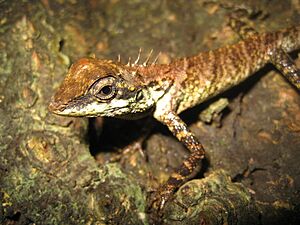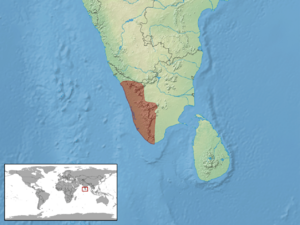Monilesaurus ellioti facts for kids
Quick facts for kids Monilesaurus ellioti |
|
|---|---|
 |
|
| Conservation status | |
| Scientific classification | |
| Genus: |
Monilesaurus
|
| Species: |
ellioti
|
| Subspecies | |
|
|
 |
|
| Synonyms | |
|
|
Elliot's forest lizard, scientifically known as Monilesaurus ellioti, is a type of lizard. It is an arboreal animal, meaning it lives in trees. This lizard is also diurnal, which means it is active during the day. It belongs to the family of lizards called Agamidae. You can only find this species in the Western Ghats region of India. This makes it endemic to that area.
Contents
About Elliot's Forest Lizard
What's in a Name?
The second part of the lizard's scientific name, ellioti, is a special tribute. It honors Walter Elliot. He was a Scottish naturalist. A naturalist is someone who studies nature.
Where Does It Live?
Elliot's forest lizard is found only in the Western Ghats of India. This mountain range is its only natural home. You can spot these lizards in several specific areas. These include Anaimalai, Agasthyamalai, and the Cardamom Hills. They also live in the Palni Hills, Nilgiris, Waynad, Coorg, and Kudremukh.
Its Home and Habitat
This lizard prefers to live in rainforests. It also makes its home in nearby plantations. These plantations grow crops like coffee, cardamom, and tea. You might even find them in Areca and vanilla farms. They can live from sea level up to about 1,100 m (3,600 ft) high.
Physical Features
Elliot's forest lizard has some unique features. Its head scales are slightly ridged. These scales overlap like roof tiles. They are larger around its eyes. There is a small spike behind its eyebrow-like ridge. Two more spikes are on each side of its neck.
The lizard has a small ear opening called a tympanum. This opening is about half the size of its eye. It does not have a large throat pouch. The scales on its throat are ridged and smaller than those on its belly. There is a strong fold of skin in front of its shoulder. Another fold crosses its throat.
The crest on its neck has a few thin, spaced-out spines. The longest spine is about two-thirds the size of its eye. The crest along its back is just a slight bumpy line. Around the middle of its body, it has between 53 and 61 scales. The scales on its snout area are similar in size to its belly scales. They are also ridged.
The scales on its belly are very ridged. When its back leg is pressed forward, it can reach its eye or the tip of its snout. Its fourth finger is longer than its third. The tail is not very flat.
Elliot's forest lizard is usually olive green on top. It often has dark brown bands across its body. These bands can look like angles. There is a black mark on each side of its neck. A white spot can be seen below its eye. Dark lines spread out from its eye.
This lizard can grow to about 3 in (7.6 cm) long from its snout to its vent (the opening at the base of its tail). Its tail can be quite long, reaching about 8.5 in (22 cm).
Reproduction
Elliot's forest lizard is oviparous. This means that the female lizard lays eggs. The young lizards then hatch from these eggs.





